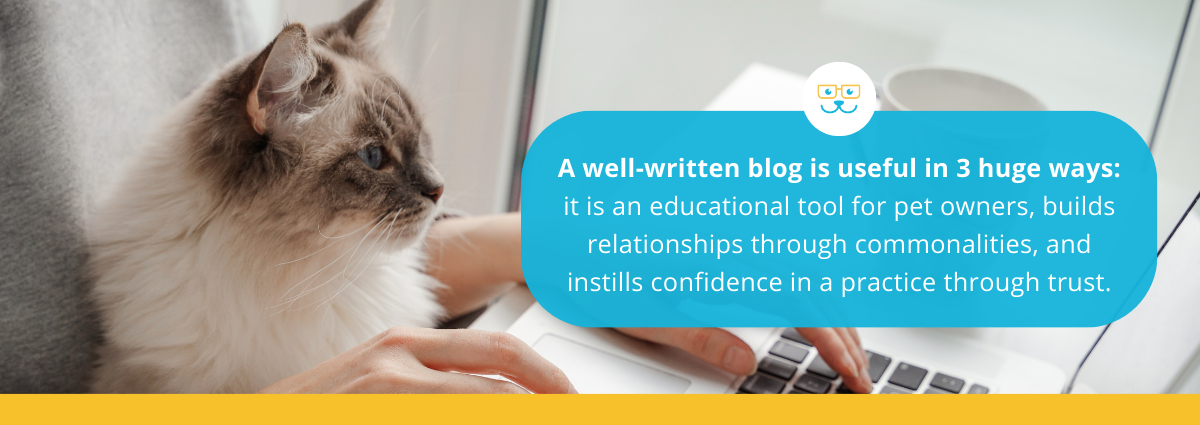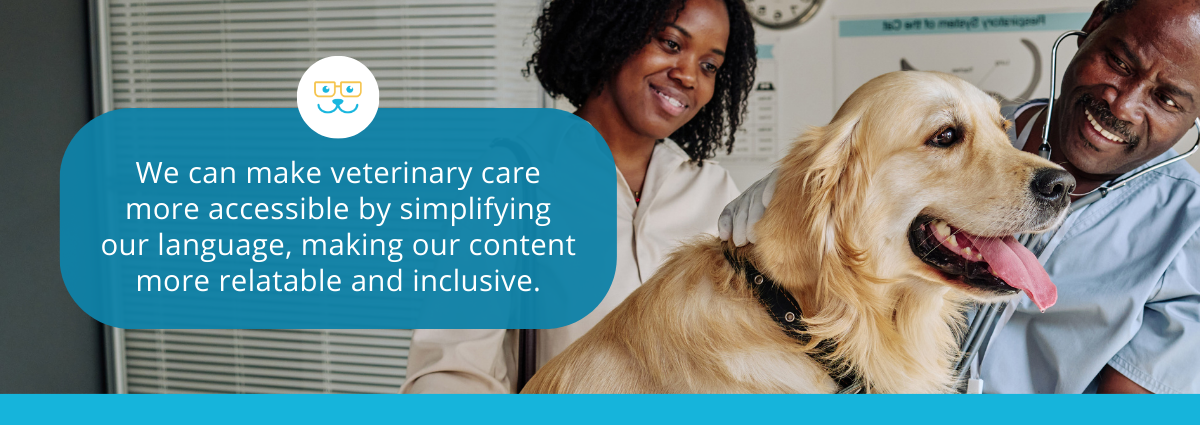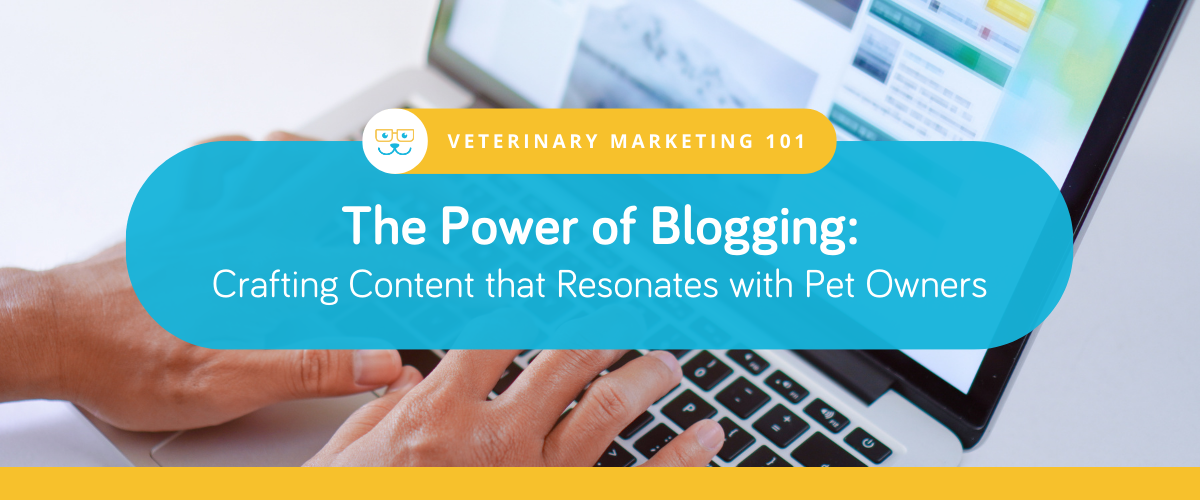The Power of Blogging: Crafting Content that Resonates with Pet Owners
Every patient has a story to tell in the world of veterinary care. From complex medical cases to routine check-ups, each visit to the clinic is an opportunity to weave a narrative that educates and builds trust with pet owners. In this blog, we delve into the art of veterinary storytelling, exploring the power of anecdotes and case studies to create engaging and informative content that resonates with both seasoned pet enthusiasts and those new to the world of fur and feathers.
We will begin to break down how blogs serve as a testament to a practice's commitment to animal health and the well-being of pet owners. They show that behind every treatment, diagnosis, and service offered, a team of professionals is dedicated to supporting and guiding pet owners through the joys and challenges of pet parenthood.
The Power of Storytelling in Veterinary Blogging
Veterinary blogging is not just about medical jargon and clinical procedures; it's about connecting with pet owners on a personal level. Sharing stories helps demystify the veterinary process, making it accessible and relatable to a broader audience. By narrating intricate or routine cases with simplicity and clarity, we aim to bridge the communication gap between veterinarians and pet owners.
Leveraging Animal Case Studies: Education, Connection, and Confidence
In the world of veterinary medicine, case studies are not just medical accounts; they are powerful narratives that have the potential to educate clients, foster relationships, and instill confidence in veterinary practices.

An Educational Tool
First and foremost, case studies serve as an invaluable educational resource. Each story of a pet's health journey – be it recovery from an illness, management of a chronic condition, or successful surgical intervention – offers insights into various aspects of animal health care. These real-life examples help explain complex medical conditions and treatments, making them more accessible and understandable to pet owners. By sharing stories like Max’s miraculous recovery or Sophie’s battle with hip dysplasia, we provide clients with practical knowledge about pet health, empowering them to make informed decisions about their own pets' care.
Builds Relationships
Narratives have a unique way of connecting with people; animal case studies are no exception. They humanize the often technical and intimidating world of veterinary care. When potential clients read these stories, they see more than just medical successes; they witness the compassion, dedication, and expertise that go into every case. This connection is crucial in building trust and rapport with current and prospective clients. It underscores the fact that veterinary practices are not just about treating animals; it's about caring for our furry family members.
Instills Confidence
Lastly, case studies are a testament to a veterinary practice's capabilities and achievements. They provide tangible evidence of the practice's expertise, innovative approaches, and commitment to animal welfare. For instance, sharing how a challenging case was approached, the diagnostics used, the treatment plan implemented, and the eventual outcome demonstrates the practice's proficiency and adaptability. This transparency and openness educate and reassure clients that their pets are in capable hands.
Examples
The Tale of Max's Recovery: Overcoming a Canine Crisis
- Max, a spirited Labrador, faced a sudden health crisis. Through a series of diagnostic tests and treatment plans, we take you on Max's journey from illness to recovery, showcasing the expertise and dedication of our veterinary team.
- Be sure to Include images of Max during the recovery process with permission from the pet owner!
Routine Wellness Checks: The Basics of Pet Care
- Not every story needs to be a dramatic one. Routine wellness exams play a crucial role in preventive care. Join us as we follow Bella, a healthy cat, through a routine check-up, emphasizing the importance of regular veterinary visits in maintaining pet well-being.
- Including images of Bella during her routine exam with permission from the pet owner is a great addition!
Embracing Simplicity in Veterinary Language
The complexity of medical terminology can often become a barrier to understanding for pet owners. Recognizing this, we emphasize the simplicity of language in our storytelling. Our goal is to bridge the gap between intricate veterinary concepts and the pet owners who seek to understand them.

Making Veterinary Care Accessible
The essence of effective communication lies in its accessibility. When sharing case studies or discussing various aspects of animal health, we consciously avoid jargon and technical terms that might perplex our audience. Instead, we opt for layman's terms, ensuring that our narratives are as engaging as they are informative. By simplifying our language, we make our content more relatable and inclusive, catering to a diverse range of pet owners with varying degrees of familiarity with veterinary terms.
The Power of Understanding and Clarity
Pet owners must entrust us with the care of their pets, and part of that trust comes from the understanding of what that care entails. Simplifying our language is not about diluting the science; it’s about enhancing clarity and empathy in our communication. By presenting information straightforwardly and comprehensibly, we empower pet owners to participate actively in their pets’ health journey. This clarity in communication fosters a deeper sense of trust and
reassurance.
Our approach to using simple language is rooted in the belief that informed pet owners are better equipped to make decisions about their pets' health. They become more engaged and proactive in their pets ' care when they understand the 'why' and 'how' of our treatments and recommendations. This understanding is pivotal in forming a collaborative relationship between veterinarians and pet owners, where both parties work hand-in-hand for the well-being of the animal.
The Heart of Veterinary Blogging - Connecting with Pet Owners
Veterinary blogging is much more than just a digital marketing strategy; it's a powerful platform for connection, education, and community building. By sharing knowledge, experiences, and insights through well-crafted blogs, veterinary practices enhance their online presence and establish themselves as empathetic, informed, and trusted advisors in the eyes of pet owners.
The true essence of veterinary blogging lies in its ability to resonate deeply with pet owners. Whether it's through providing helpful pet care tips, explaining complex medical procedures in simple terms, or sharing heartwarming patient stories, each blog post contributes to a stronger bond between the practice and its clientele. This connection fosters trust, loyalty, and a sense of community – invaluable assets in the ever-evolving world of veterinary care.
As far as we can see, the role of veterinary blogging in shaping the relationship between veterinarians and pet owners will only continue to grow. By embracing this medium with passion and purpose, veterinary practices can make a lasting impact on their communities, one blog post at a time. Ultimately, a veterinary blog is more than just a collection of articles; it's an ongoing conversation that enriches the lives of both pets and their owners.
Need help with blogging? GeniusVets has an extensive content library and support to help you with your goals. Get in touch with our team today and schedule a demo.

